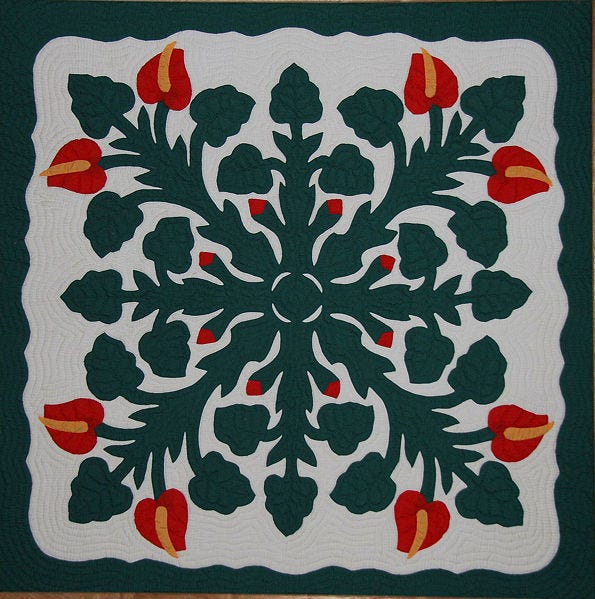ALSO KNOWN AS: Abutilon menziesii, red ‘ilima
How to know:
Tall stalk with tiny hairs (trichomes)
Petals that range from scarlet to coral
A showy pistil
Large rounded leaves with small teeth along the edge
The ko’oloa’ula shimmers from head to toe, and even though it can reach ten feet in height it likes to faint. It falls down frothing in a shrublike fashion with silvery leaves and tiny glimmering gems of flowers. This plant is large but disappearing.
On an Island in the Sun
The ko’oloa’ula is endemic to O‘ahu, Maui, Lāna‘i and Hawai‘i. They are found growing naturally nowhere else in the world. And while some cultivars are looked after their cuttings are finicky and this is not a commonly cultivated plant. On top of this, they are critically endangered. Unlike the vigorous and, essentially, non-flowering pothos plants, the ko’oloa’ula relies heavily on flowering and pollinators to propagate. However pollinators on the islands are in jeopardy which has effected many of the native species. At the moment only 5 percent of all insects are native to the islands, which has a devastating effect on plantlife there.
Because the Hawai’ian islands are the most isolated archipelago in the world, much of the wildlife there is endemic. To this end, so too are the invasive species. Vegetation has also been eaten by invasive pigs and goats that can make it difficult for plants to sustain and renew themselves.
The leaves of the ko’oloa’ula can be one to five inches but the flowers are tiny red eyes dappled in pollen in a tall green body. They look like bells with disks of red petals that often droop to look at the ground. The flowers have a vast range from a softened buttery color to a deep wine red from. These blooms have a reproductive body that has always reminded me of a dental instrument, with bristled anthers, which hold the golden pollen, and out of the top of them emerge around six nectar-filled styles.
The leaves are soft green with a tinge of silver and a rim of small teeth, but the leaf shape can vary depending on the conditions. Sometimes the leaves are wide hearts, and sometimes they are long almonds. Their seed capsules look like teardrop shaped lanterns and they hold five seeds per pod.
Despite growing in the wet climate of Hawaii, the plants are drought resistant. They are one of those plants who grow in a tangled shrub in the dry and quiet leeward slopes of the islands, which are usually southwest facing.
The plant is so rare there are only a few locations where this plant was known to live, and one of those places had plan for a road to run through it. For the ko’oloa’ula, the Dept. of Transportation found that it was easier to move the plants than to reroute the road and completely destroy the population. To achieve this there was money dedicated to one person who would ensure this plant had a future in Hawaii. Greg Mansker was tasked to come up with strategies to save these plants. They are now being grown in highly protected areas, surrounded by predator-repellent fences and behind gates. But this does not protect against the fires and storms that are also projected to worsen with climate change.
The Ōlelo Hawaiʻi, indigenous Hawaiian language, has kept the name for the plant, and with any hope this plant’s name will continue to be spoken as it is nurtured in the future. The “ula” refers to red, but the flower can come in softer warm colors of orange or yellow. These blooms continue throughout the year, except for on the hottest days of the season.
Of Sweet Kin
The genus to which it belongs is called the abutilon, a tropical and subtropical genus many of whose plants are lined with dark veins that give the plants two tones.
It isn’t a surprise to see the ko’oloa’ula’s connection with the hollyhock family, or mallow family, a queen of which is certainly the hibiscus. These plants that generally occur in China, but have been found throughout the world. Well known plants in this species are also the okra, baobab, and durian. These plants have been associated with a deep energy, a lush and abundant significance that covers the heavy durian fruit, the sweet sorrel of hibiscus juice with its fathmoless redness. Even the sap from marshmallow were, in ancient Egypt, a delicacy. Over thousands of years became the marshmallow of the campfire, of summer. This species of plant brings a kind of lux quality to its habits.
The ko’oloa’ula plant is among a strong medicinal lineage. Though there is little readily accessible about its ethnobotanical uses there is no doubt it has been useful to people for many generations. Its strong fibers might have been used as cordage. The plant may have been used as a dye the way hibiscus can.
Myth for Koʻoloaʻula
Not to be confused with the Ilima though they can grow beside one another, these plants. Ilima is an important cultural plant that can shape shift depending on its environment. These flowers are yellow.
Or marshmallow - yes - this is a flower, though they share the same family and the showy pistils, marshmallows usually have ever so slightly more squared petals.
Forager Friendly?
No, this species is endangered.
Sources
https://www.nativehawaiiangarden.org/flowering-plants/kooloa-ula
https://www.waikoloadryforest.org/plants/kooloaula/
https://luc.hawaii.gov/wp-content/uploads/2017/10/SP17-409_CC_Exhibit2-AppendixB.pdf
https://www.nativehawaiiangarden.org/flowering-plants/kooloa-ula
http://hawaiiecoregionplan.info/ecoregion.html
https://sweetgum.nybg.org/science/the-hand-lens/explore/narratives-details/?irn=6960
https://ecos.fws.gov/ecp/species/3268
https://www.marinelifephotography.com/flowers/rare.htm
https://www.earthisland.org/journal/index.php/articles/entry/hope-hawaiian-pollinators-bees/##
https://www.ngv.vic.gov.au/explore/collection/work/34996/







